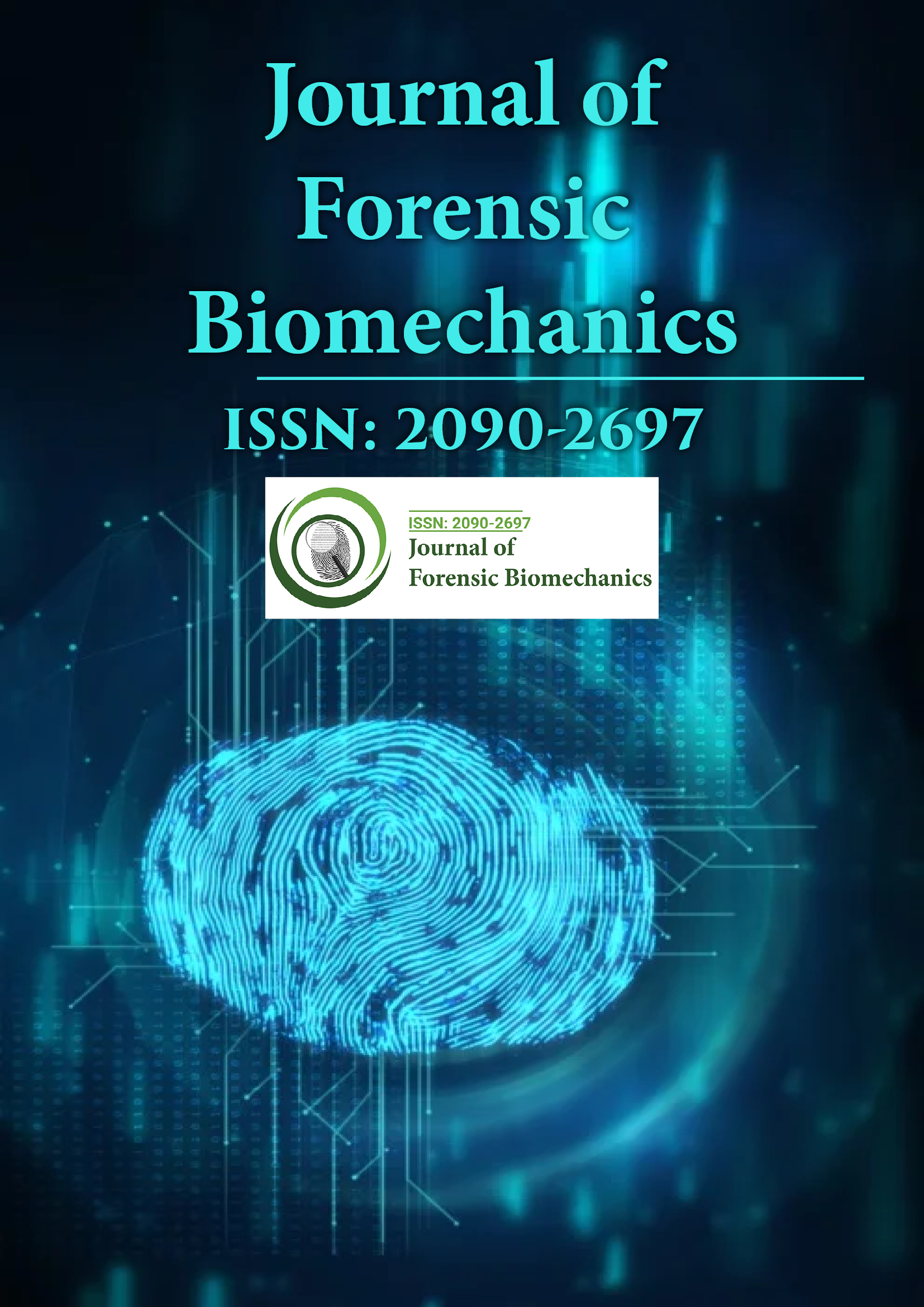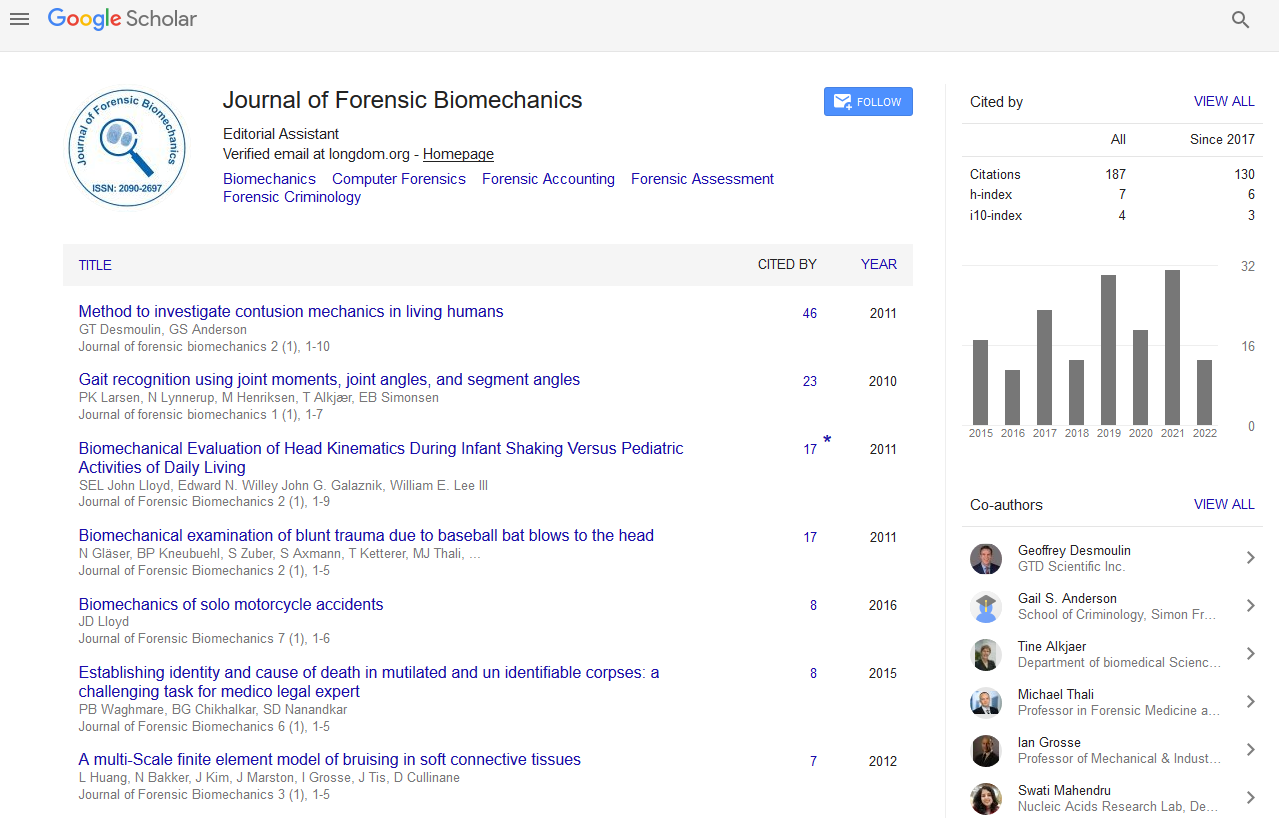Indexed In
- Genamics JournalSeek
- SafetyLit
- Ulrich's Periodicals Directory
- RefSeek
- Hamdard University
- EBSCO A-Z
- Geneva Foundation for Medical Education and Research
- Euro Pub
- Google Scholar
Useful Links
Share This Page
Journal Flyer

Open Access Journals
- Agri and Aquaculture
- Biochemistry
- Bioinformatics & Systems Biology
- Business & Management
- Chemistry
- Clinical Sciences
- Engineering
- Food & Nutrition
- General Science
- Genetics & Molecular Biology
- Immunology & Microbiology
- Medical Sciences
- Neuroscience & Psychology
- Nursing & Health Care
- Pharmaceutical Sciences
Perspective - (2025) Volume 16, Issue 1
The Biomechanics of Impact: Forensic Insights into Accidental and Intentional Injuries
Samuel Merry*Received: 01-Jan-2025, Manuscript No. JFB-25-28534; Editor assigned: 03-Jan-2025, Pre QC No. JFB-25-28534 (PQ); Reviewed: 17-Jan-2025, QC No. JFB-25-28534; Revised: 24-Jan-2025, Manuscript No. JFB-25-28534 (R); Published: 31-Jan-2025, DOI: 10.35248/2090-2697.25.16.514
Description
Injuries from unintended drops or accidents are a leading cause of harm and fatalities. Especially among the elderly and in forensic investigations involving accidents or suspicious circumstances. Understanding the biomechanics of falls is essential in forensic science, as it helps differentiate between accidental falls, self-inflicted injuries cases involving external forces such as homicide or abuse. By analyzing injury patterns, impact forces environmental factors, forensic experts can reconstruct fall incidents with a high degree of accuracy, providing valuable insights in criminal and civil cases.
Biomechanics is the study of how forces interact with the human body. In the case of falls, it examines how a person’s body moves, accelerates absorbs impact energy upon hitting the ground or another surface. The severity and nature of injuries depend on multiple factors, including the height of the fall, the surface characteristics, the orientation of the body at impact the individual’s physical condition. By evaluating these factors, forensic investigators can determine whether an injury is consistent with an accidental fall or if other forces were involved.
The height from which a person falls plays a significant role in the resulting injuries. Low-height falls, such as slipping on a wet floor, typically result in localized injuries like wrist fractures, minor head trauma, or soft tissue bruising. In contrast, highimpact falls, such as those from buildings or staircases, lead to more severe injuries, including skull fractures, spinal damage internal bleeding. The biomechanics of high falls involve greater velocity and force upon impact, often resulting in a higher likelihood of fatal injuries. Forensic scientists use calculations of gravitational force and body acceleration to estimate fall dynamics and compare them to injury patterns.
The surface onto which a person falls also influences injury outcomes. A hard surface, such as concrete or tile, produces more severe fractures and head trauma than a softer surface like grass or carpet, which absorbs some of the impact energy. In forensic cases, experts examine the consistency between reported falls and the injuries sustained. If a person claims to have fallen on a soft surface but presents with extensive fractures, investigators may question the legitimacy of the account. Additionally, forensic scientists assess secondary impact injuries, which occur when a falling body strikes multiple surfaces before coming to rest, such as tumbling down stairs or hitting furniture.
The biomechanics of falls are also critical in cases involving the elderly. Older adults are particularly susceptible to falls due to factors such as weakened bones, poor balance reduced reaction time. Forensic investigators consider whether an injury aligns with natural fall risks or suggests external involvement, such as neglect or abuse. For example, unexplained bruises, multiple fractures in different healing stages, or injuries inconsistent with a reported fall may indicate mistreatment in elder care settings.
As forensic biomechanics continues to evolve, its role in solving fall-related cases will become even more significant. Whether in crime scene investigations, legal disputes, or elder care assessments, understanding the science of falls provides objective, evidence-based insights that help uncover the truth. By applying principles of physics, medicine engineering, forensic experts can determine how and why a fall occurred, ensuring justice and accuracy in forensic investigations.
Citation: Merry S (2025). The Biomechanics of Impact: Forensic Insights into Accidental and Intentional Injuries. J Forensic Biomech. 16:514.
Copyright: © 2025 Merry S. This is an open-access article distributed under the terms of the Creative Commons Attribution License, which permits unrestricted use, distribution reproduction in any medium, provided the original author and source are credited

